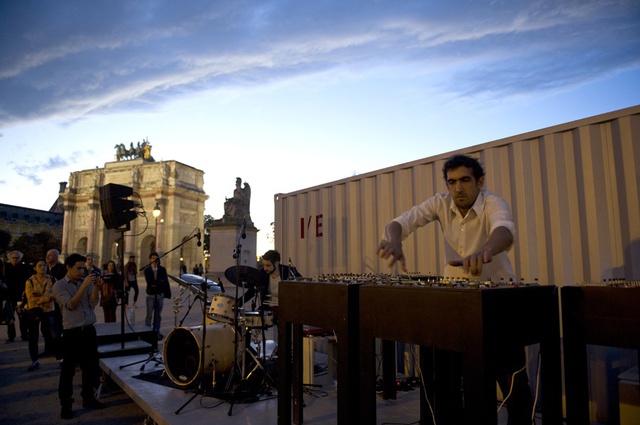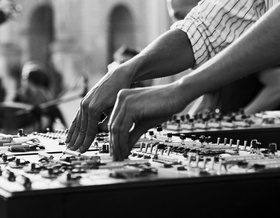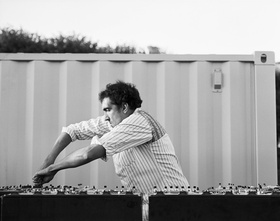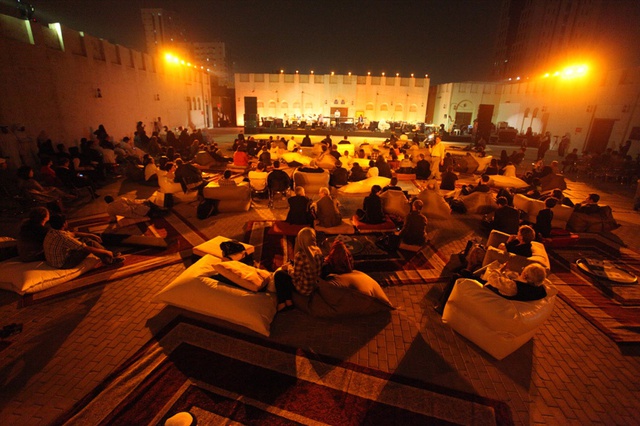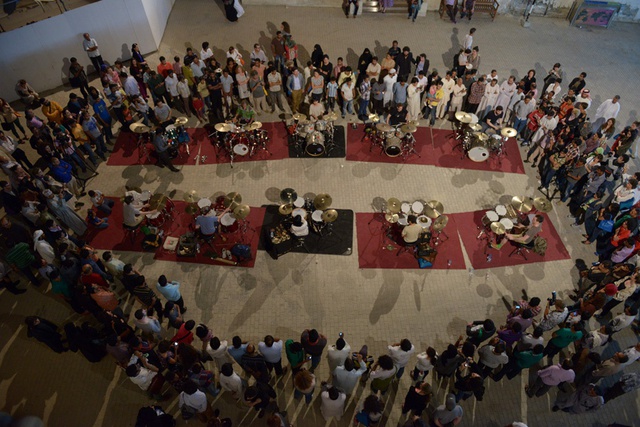Interviews
The Art of Resonance
Tarek Atoui in conversation with Stephanie Bailey
Tarek Atoui's artistic practice engages with sound as a force for communion and interrogation. It began when he was a student of contemporary and electronic music at the French National Conservatory of Reims, building new software and creating computer tools for interdisciplinary art forms and educational practices. Atoui worked in several electro-acoustic studios in Europe before taking the artistic direction of the STEIM studios in Amsterdam in 2007, and since 2008, he has worked with the Sharjah Art Foundation (SAF), a collaboration that has influenced the direction with which his work has taken. In this time he has created projects in collaboration with SAF, including a series of education projects and collective and theoretical compositions including On and From Tarab (2011–12), which incorporated elements of the world's largest collection of Classical Arab music owned by Lebanese collector Kamal Kassar and comprising of old 78 rpm shellac discs and studio tapes dating between 1903 and 1950, which premiered as Visiting Tarab as a Performa 11 commission with SAF. In this interview, Atoui discusses the way his work has evolved since 2008, and how it has moved towards working with audiences.
Stephanie Bailey: As Platform 007 is about future institutional practices, infrastructures and developing audiences, I thought it would be good to begin with how your work has developed with the Sharjah Art Foundation. Your relationship with the institution really started with the first March Meeting in 2008. How do you recall that first experience of the March Meeting?
Tarek Atoui: The first March Meeting was the Young Arab Theatre Fund, Start, and the Sharjah Biennial coming together and sharing a set of questions as institutions initiating projects or funding projects in the Arab world. It also included artists and practitioners who had a strong implication in the region through educational or research projects, or curatorial practices that were being implemented in different countries. The concerns at the time were around production, residencies and research, and we worked around these themes. I was invited because, since 2005, I had been involved in initiating many educational projects, not only in Beirut but also in Cairo, and I was thinking about young audiences and giving workshops to young artists. So I came to Sharjah and took part in this first discussion group. At that time, I always made a distinction between my own work and the educational work I was doing.
SB: Then you were invited back to Sharjah for a six-month residency…
TA: Yes. I returned to Sharjah a few months after the first March Meeting but on different grounds – this residency was to develop my own work and to produce a commission to participate in the 2009 Sharjah Biennial.
SB: Can you talk about the early education projects you mentioned in Beirut and Cairo?
TA: This comes from my background as a student studying sound art in France, as well as my interest in performance, my research into the use of instruments in performances, electronic instruments, and collaborations I had with studios in Paris working around notions of electronic instruments and pedagogy. I was developing educational software and educational tools and then I started going back to Lebanon – the first time was in 2005. Whilst being in Lebanon, I could very easily identify different publics with whom I could do this kind of educational work. It also made sense to do this work with these audiences, because when I first returned to Lebanon working with the Palestinian community was something I was very attentive to.
SB: What drew you to sound and music?
TA: I don't know, honestly! I never imagined that I would be a musician and I really don't consider myself to be one. I guess I am a musician whether I like it or not, but I never considered myself to be part of the musical community or the musical economy. Music came in at a later stage, when I travelled from Lebanon to France and met with experimental and contemporary music.
SB: You have a real awareness for audiences, which relates to your practice as one that is highly performative in that it engages with ideas of communication and transmission.
TA: Yes of course. From when I was a student, I was not interested in composing music for albums or working on fixed forms of composition. I was more interested in performance. As a teenager I was a DJ playing techno music and the connection with the audience was very important to me even then. So at the conservatory, I focused on performance very early on and was thinking of ways to reconnect body and sound.
SB: This brings us to Within (2013), a collective performance that you composed and produced for the 11th Sharjah Biennial in 2013. For this piece, you worked with the Al Amal School for the Deaf and with a number of drummers in order to create a composition that worked as a set of parameters. When the composition was performed, it began with ten drummers performing solo around Sharjah, often improvising, and moving through the city until they grouped together in groups of two or three, leading to the end of the performance, when all the drummers formed a single group and performed together. I wanted to go back to how your work with Sharjah constituted a turning point, in that after 2008, you really started to engage with the public sphere. You have said that you started to sacrifice the quality of sound so as to reach new publics directly, and with Within this happened because you took sound directly into the city.
TA: In order to perform the way I wanted and imagined, I learned computer programming and writing project-specific software became fundamental in my work and instrument making. Computer programming lead me to think in a modular way and to think about composition as the sum of independent modules that can come together through the performance. So the idea of collaboration and how I started to invite and work with musicians is actually very much influenced by computer programming techniques.
SB: This recalls ideas around cybernetics in the 1970s and this idea of anarchism and self-organization that was embedded into these ideas, which reminds me of I/E (2013), a sound-proof shipping container you turned into a studio. You defined and presented the work as a collective instrument – not really a place for sound but a place for unbalanced realities. It seems there is a metaphor in I/E that relates to the aural dissonance of Within. Could you talk about that?
TA: I/E is a collective instrument that responds to outdoor situations. On this project, I wanted to propose new ways of working with concrete sound and field recording. For me, working in, out and from exterior environments has become important. The environment is not just sound material or a sound source – its acoustics and social dynamics, for example, can inform composition and inspire news ways to perform and collaborate. This is the case with Within.
SB: This recalls On and From Tarab in which you explored the history of classical Arab music through the extensive archive of Kamal Kassar. You said you actually wanted to engage with this history so that it could become something else – so that you could almost change its form.
TA: On and From Tarab is about looking and learning from classical Arabic music and thinking about what it had to teach us in terms of the performance pace, the orchestra, the rules improvisation, the relationship to time and space. It wasn't about reproducing classical Arabic music or remixing it, and rather then becoming a fusion, it was much more about synthesis.
SB: This returns us to this idea of unbalanced realities contained or mediated: Within, On and From Tarab, I/E – these projects feel like the containment of dissonance, or more so an enabling of different elements to exist and unfold in one space as a complex composition.
TA: For me, there is no dissonance at all, or at least no musical one. Actually, On and From Tarab and Within made me think deeper about what contemporary composition is and to consider whether it is about dissonance, resonance or harmony, or all of these things together. My work as a composer is to let these things be by giving them the parameters to co-exist. For me, my role as a composer starts with setting up the constraints of the encounters and the collaborations that my pieces generate. These constraints are the space, the relation to the audience, the relation between the performers – this was the case with I/E.
SB: This is what I was getting at, because the question of dissonance makes me think about relation, especially when considering how Within worked with its audience during Sharjah Biennial 11. This was a very specific biennial, which came after Sharjah Biennial 10, which – as we know – was a very heated moment. I think Yuko Hasegawa's approach to Sharjah Biennial 11 was to clear the air in some ways after the events of 2011 and 2012. In regards to this, did Within act as a mediation between the institution of the Sharjah Biennial and its public? As you noted, the work did reflect on the cultural complexities of Sharjah, which contain a certain dissonance in some ways…
TA: I was sensitive to where the Sharjah Art Foundation was in its development and in its work. Jack Persekian had the ambition to connect the Sharjah Art Foundation to its local context, then Sheikha Hoor continued this approach. In 2012, I did a very meaningful workshop with the Al Amal School for the Deaf, and when I got the invitation to participate in SB11, I saw an opportunity to continue the dialogue with the school and go further. This became the start of Within.
SB: You said that in producing this work you were moving between many different roles, from artistic director, composer, teacher and researcher to performer and programmer, so it was very fluid in that sense – mediatory, almost.
TA: Yes, exactly. With Within, I was happy with the complex but efficient network of connections and circulations that I created on this composition. I find that the students of Al Amal are the best example of this. The performance of the drummers, which comprised the start of the composition for Within, came out of an inquiry that the Council – curators Sandra Terdjman and Gregory Castera – did with the students. Then, during Within, the students met the drummers and told them how they perceived the sound and how they felt it. This encounter was a key moment for me as it affected my understanding and directing of the drummers. Then, these students came back and took part in the workshop sessions the Council set up in Sharjah. Finally, for the closing week of the Biennial I returned to Sharjah and worked with the students on a performance that took our collaboration in 2012 further. What was also meaningful to me with this piece is that it articulated education, knowledge production and sound performance in interdependent non-linear ways and that are challenging for an institution. But here again, the Sharjah Art Foundation showed its full support and created ideal contexts for the project.
SB: In some ways, thinking about fluid roles, the thing about Within is that everyone became a participant: everyone became 'the audience'…
TA: Yes. We were all audience members, from the people of Sharjah, to the musicians who came from all over the world.
SB: When you have talked about Within, and how the students from the School of the Deaf responded to sound, you have mentioned how students preferred strong, clear, unelaborated drumming, as it was easier to ascertain the sounds through vibration. In fact, more elaborate, ornate drumming was unbearable for them because there was no identification. This relates to this idea of unbalanced realities again, and how we can have different perspectives or experiences of the same thing, which points to the fact that we experience common things literally within. I wanted to see how we could relate this to Un-drum (2010), a three-part physical electronic sound performance…
TA: Un-drum is mainly about a way of composing and performing. There were themes associated with each movement, but these were starting points and responses to specific contexts or situations I found myself in. Part one, for instance, used a personal event that happened to me in 2006, when I was arrested in Lebanon, as a reference. But the most interesting and fundamental thing about Un-drum was the way body, composition and instruments were articulated within the same production process. It led to these performances where the relation between me, the sound and my instrument become very complex and exciting. It was about the performer, the indication of my body and the act of making sound. The third part of Un-drum was a theme I really liked: it was about sampling and microsampling, which is really pertinent.
SB: Why pertinent?
TA: Pertinent because the idea of microsamples that emerged from this project was fantastic. Un-drum 3 was all based on taking things from very well-known repertoires. For example, you take the Beatles or you take Madonna or you take things that everybody knows and you listen to them and ask what is the smallest element or chunk of sound that is recognizable inside of them? If I would have to synthesize Michael Jackson to the smallest sound unit, what would that be?
So the whole work of Un-drum 3 was about microsamples and using very small chucks of sound, really small. At some point it was erosion in that it became only preserved sounds with a potential of evocation. It was also a response to the word 'sampling', as in hip-hop, electronic music and even in experimental and contemporary music. On Un-drum 3, the challenge was to find this ephemeral and familiar sound material and articulate it meaningfully. After Un-drum 3, microsamples became fundamental to me and I use them often.
SB: Sampling has also been something that's always been prevalent in your work, namely On and From Tarab, which also brings in ideas of appropriation and the question of attribution or ownership…
TA: Yes. Microsamples go beyond jurisdiction and the laws of authorship.
SB: This recalls the notion of resonance, in that it is about how sounds become something shared once they are released. I wonder how you define resonance and how you see its function in your work?
TA: Resonance is often understood as the 'after' – the aftershock or the after encounter. For me it's also a 'beyond' as jazz and free jazz musicians define it. In Within, there was resonance. There was a resonance with the audience, with the architecture, with bodies and with knowledge.
SB: I feel like that is such a big part of your practice. I remember during Within I was watching the audience, which included young local children and thinking: they are going to remember this moment, and I wondered how this memory would resonate for them in the future. This ties in with the institution of SAF, what is being built in Sharjah, and your role is in this evolution…
TA: With SAF, I have a relation based on mutual understanding. The Sharjah Art Foundation knows my work very well and I'm sensitive to the role of the Foundation and to the challenges it's facing locally, regionally and internationally. Simply said, I think if there's resonance it's because the Sharjah Art Foundation, the place and the people, gave me a lot and this made me want to give back.
SB: You are both in the same container…
TA: Exactly.
SB: This leads to the relation produced by sound, and the potency of sound as a material of resonance. The thing about sound is that it is one of the most immediate ways to touch the audience, figuratively of course, and literally, through vibrations. You have said that this growing awareness of sound and the potency of vibration has changed your perception of how sound can be used in both local and global contexts…
TA: Yes. And it goes beyond this. From how Within developed out of the local context of Sharjah, and with the work we did at the School for the Deaf, to the presentation of the performance as part of Sharjah Biennial 11, we have been able to reach something that was much more potent. What we learned about vibrations and the perception of sound through working with the students and engaging with the participants in this piece, was that the potential of sound goes beyond regions or cultural characteristics.
Tarek Atoui was born in Lebanon in 1980 and moved to Paris in 1998 where he studied contemporary and electronic music at the French National Conservatory of Reims. Co-artistic director of the STEIM Studios, Amsterdam (2008), Atoui released his first solo album in the Mort Aux Vaches series for the label Staalplaat (Amsterdam/Berlin) in 2006-07. He builds new software for each project and specialises in creating computer tools for interdisciplinary art forms and youth education. Atoui has worked with the Sharjah Art Foundation since 2008 when he became artist- in-residence. During this period he created Un-drum/Strategies of surviving noise (2009). He later composed Un-drum 2: the Chinese connection (2009) which was performed during Disorientation II. He has also worked in the context of the Foundation's Education Programme, leading workshops on art and technology for university students, teenagers and museum professionals in the UAE and the region. Recent productions and performances have taken place at the New Museum, New York (2010), Manarat Saadiyat, UAE (2009), Sharjah Biennial (2009), La Maison Rouge, Paris (2009) and the Today’s Art Festival, Amsterdam (2007). Much of Atoui’s work references social and political realities and presents music and new technologies as powerful tools of expression and identity. His pioneering youth workshop, Empty Cans, has been presented in France, Holland, Lebanon, Egypt, and in New York, as part of his Museum as Hub residency at the New Museum.

